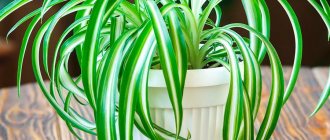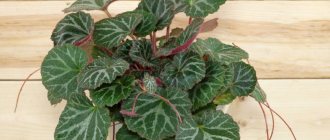Views: 1,774
Begonia is one of the most beloved and popular ornamental plants. This charming delicate plant often decorates the window sills of apartments, houses, offices, gardens and flower beds. It is famous not only for its flowers, but also for its beautiful leaves.
In 1687, Michel Begon organized an expedition to the West Indies to search for new plant species and study in more detail those already known to science.
The expedition was a success - the monk and botanist Charles Plumier discovered six plant species unknown to science in the Antilles. After studying and describing the plant, it was named “begonia” - in honor of the founder and leader of the expedition.
- Home begonia - description of the plant
- Plant species
- Begonia varieties
- Beauty of Begonia: name of species
Begonia can be found in South America, India, mountainous Asia (Himalayas) and even in western Africa. This is the largest plant in a family that has more than 1000 species.
In addition to the names of varieties and species, you can find useful information on the pages of my blog about how to care for this plant, how to propagate, how to carefully treat diseases and control pests.
How to properly care for begonia at home
Begonia is one of the most beautiful plants that decorates our squares, parks, gardens and apartments. The flower belongs to the huge family Begoniaceae. Today, this genus has about 900 full-fledged and 2000 hybrid species. Begonia was first described back in 1690 by Michel Begon, and it began to be used for decorative purposes only 200 years ago.
From the history
The history of begonia began in the Antilles, where Michel Begon first described it. Subsequently, this flower was named after him. A few decades later, an ever-flowering begonia native to Brazil was described, and even later, a royal begonia from the Hindustan Peninsula and a tuberous subspecies from South America. It is from them that all modern varieties originated. After the widespread use of this flower for decorative purposes, begonia became incredibly popular: at first it was only a greenhouse flower, and then those that can easily withstand climate surprises appeared.
Today, all over the world there are a huge number of hybrid forms and varieties of cultivated begonia.
All types of begonia are divided into groups according to their decorative qualities:
- Decorative flowering;
- Ornamental deciduous.
The most popular species is tuberous begonia. It boasts incredibly vibrant flowers and, most importantly, they are very easy to care for. The place where begonias grow can be called the tropics and subtropics. They prefer shady and damp places, but are also found on steep seashores at an altitude of 4000 meters, in the mountains and on arid slopes.
Variety of shapes and types of begonia
Begonia is diverse not only in shape, but also in size and color. It can be a herbaceous plant, 3 cm long, or it can be a fairly large shrub. Begonias can be stemless or have just one leaf. The leaves themselves are colored in any shade of green; the reverse side of the leaf is either plain or covered with multi-colored spots and patterns. Begonia flowers have a wide range of colors, mostly warm colors.
Begonias are indoor plants that can bloom not only in summer, but also in winter. Decorative-flowering species are plants with large, bright flowers, while decorative-deciduous species have beautiful, rich foliage, but their flowers are less attractive. The leaves themselves are covered with bright pubescence.
Lighting
For begonias, it is very important that the light is bright. Flowering specimens especially urgently need this. In summer, it is best to shade the begonia from direct light, otherwise sunburn may occur. Decorative deciduous begonias are suitable for diffused light; they are best placed on eastern or western windows.
Temperature
The most optimal temperature for this flower is 21-23 degrees in summer, and in winter not lower than 15-18.
Air humidity
Because of its origin, begonia loves high humidity, but it is not recommended to spray it. This is due to the fact that when water gets on the leaves it provokes the appearance of brown spots. To ensure that the plant does not suffer from excessive dry air, you need to place the plant on an inverted pallet, and then the entire structure must be placed in an even larger pallet. Expanded clay should be poured around the circumference, which should be periodically moistened. By evaporating, the water will maintain the moisture balance necessary for the begonia.
Watering
On hot summer days, begonia needs to be watered very generously, but do not allow water to stagnate in the tray, much less in the pot. Watering should be done with settled water when 1-1.5 cm of soil has already dried out after the previous watering. In winter, watering is reduced. Pay special attention to tuberous species: they hibernate during the winter, so they need to be placed in peat and watering should be completely avoided.
Top dressing
You need to start feeding begonia once every 2 weeks from the moment of flowering. Fertilizers with nitrogen should be used only for deciduous varieties, as they inhibit flowering, but improve leaf growth.
Problems
What to do if roots don't appear?
Refresh the cut on the cutting, which is standing in water, and change the water to clean water. You can add root to the water.- If roots do not appear in the soil, check if the soil is dry and cover the cutting to obtain high humidity.
- Check whether all conditions of detention are met.
- Change the method from soaking in water to rooting in soil and vice versa.
- Take your time and give the plant time. If roots appear in water after a week or a week and a half, then in soil it may take 3-4 weeks.
What to do if a young plant does not develop?
- Check whether all conditions for the flower are provided.
- Inspect the plant for diseases or pests. Diseases appear due to improper care and are treated with special medications. Pests can be removed manually or using systemic insecticides.
- Perhaps the plant is simply flooded with water. If the plant is really bad, you need to carefully remove the earthen lump and leave it to dry. You can replace the soil and cut off rotten roots. Then you need to return the begonia to the pot.
- If development stops in winter, there is nothing to worry about; with the onset of spring it will continue to grow.
- To improve its health, begonia can be transplanted outside in the summer. The main thing is that the landing site is protected from strong winds, rain and scorching sun.
Begonia transplant
There are no special requirements for the soil for begonia. It can be purchased at a special store, or you can easily make it yourself. If you decide to prepare the soil yourself, then you need to fill half the pot with leaf soil, and then add a mixture of peat and black soil in equal proportions. Don't forget to put some regular sand in the bottom of the pot. If you properly prepare the soil for begonia, it will delight you with its active growth for a long time.
This plant should be replanted as needed. Time has passed since the previous transplant, and now the grown roots cannot fit in the old pot. That is why the plant needs to be placed in a larger pot. It is best to replant at the very beginning of spring. The plant must be carefully removed from the pot, and the roots must be cleaned of old peat. After this, it is best to place the plant in water with potassium permanganate for a while. After the roots are cleared of sand, you will need to trim off the rotten parts.
It is very important not to fill a full pot of soil when replanting begonias. It is best to wait until the roots are completely dry and then add some soil. A plant that has recently been transplanted needs to be watered very often. Also, begonias should not be placed directly in the sun. Remember, now you need to be more diligent in caring for your begonia for a while. Typically, the settling-in time in a new place is about 1 month.
General rules for cuttings
In addition to step-by-step instructions for the process, there are rules and conditions that must be taken into account to obtain a good result:
- When and how is the best time to take cuttings? For indoor specimens, the best time is the month of March. Plants planted in spring develop in harmony with natural biorhythms. If your begonia spends the summer in open ground, you can take cuttings in the summer.
- The temperature required for successful rooting is 20-25 degrees. This is very important; roots are unlikely to form in an insufficiently warm atmosphere.
- Humidity also plays a big role in the cutting process. Therefore, to ensure a guaranteed result, a mini-greenhouse is made for the cuttings, simply covering them with a plastic bag or a cut plastic bottle. Under no circumstances should the cuttings touch the walls of the greenhouse. The cover must be removed daily for ventilation.
- The soil for rooting cuttings should be light, moisture-permeable and breathable. You can mix peat and perlite, or peat and sand.
- A large container is not needed, because immediately after small roots appear, the plant will be transplanted to its permanent place of residence. A regular plastic cup will do.
- Lighting for cuttings is necessary, as for adult plants. Therefore, during the rooting period, the cuttings should be in a well-lit place.
- For cuttings, only absolutely healthy and strong shoots are used.
Begonia propagation
This wonderful plant can be propagated in three ways:
- Leaf cuttings;
- Stems;
- Dividing the bush.
Each type of begonia has its own characteristics of reproduction, and if you do not take them into account, the plant will not only not bloom, it will not take root.
To propagate tuberous begonias, you must have seeds or tubers.
Propagation by tubers should be carried out as follows:
- In the fall, remove the tubers from the ground;
- Trim begonia leaves;
- Clear the roots from the soil;
- Place the peeled tubers in peat. You need to make sure it doesn’t dry out;
- The temperature should be within 9-11 degrees.
In order for tuberous begonia to grow well after transplantation, it must be done from February to May. For begonia to germinate, it must be planted in pots filled with sandy soil and watered moderately.
It is very important to remember that tuberous begonia germinates very slowly. The appearance of roots and shoots will tell you that the germination process has already begun.
Rules for caring for plant tubers
Planting of a tuberous plant begins from February to June. The flowering time of the perennial depends on the period in which the planting was made.
Basic landing rules:
- tubers should be only half in the soil; Place the container with soil in a dark place where the temperature is maintained cool.
- watering is carried out moderately, for several weeks
- After the shoots appear, the part of the tuber protruding from the soil is covered, the container with the plant is placed on a windowsill or other warm, well-lit place.
Begonia tubers
Begonia flowering
Begonia blooms very profusely, and most importantly brightly. Luxurious flowers in their shape resemble roses, camellias, carnations, and daffodils. The main advantage of such flowers is that they are able to bring a festive atmosphere even to the darkest places. A variety of elegant flowers decorate summer gardens from early June until September, and in apartments they can delight the eye from late spring until late autumn.
Diseases and pests of begonia
- Quite often, the leaves and petioles of begonia are subject to fungal diseases, most often powdery mildew. In most cases, it is caused by excess moisture. Carefully monitor the condition of the core of the bush, as well as the lower leaves, in order to address the problem in time. These are the places where rot and powdery mildew appear. If, after all, you have diagnosed this problem on your plant, you need to get rid of the damaged leaves and then reduce watering. This way you will be able to avoid the growth of fungus throughout the plant.
- The most common pests for begonias are red spider mites and aphids. To rid your plant of them, you need to generously spray the leaves with a solution of insecticides: Fitoverm, Intavir or Karbofos. After this treatment, you need to place the plant in a damp plastic bag to enhance the effect of the procedure. However, if you carefully care for your begonia, you don’t have to worry about such a problem overtaking you.
Necessity of pruning: do all varieties need to be pruned?
The plant needs to be pruned; without this procedure it is simply impossible to grow a beautiful and healthy creation of flora. If you do not consistently remove some of the shoots, old leaves, then the foliage and flowers are crushed, the decorative effect will not be as it should be. But not all types of begonia are pruned:
- Everblooming, Rex, Royal and their hybrids do not require pruning.
- Thick-trunked trees are shortened if necessary to form a bush.
- To stimulate the development of side shoots in hanging begonias, you need to trim the tops of the stems.
- Bush species are pruned, leaving stumps 7 centimeters high. Usually old shoots are removed in the spring.
FAQ:
Why doesn't begonia bloom?
Perhaps your begonia does not have enough light, the humidity in the room is low, the temperature is inappropriate, it is located in a draft, or you simply overdo it with fertilizers. Try to change something in its usual life: move it to another window, or to a room where the temperature is different from the one where your begonia now stands. If, despite all your efforts, the begonia withers, root a few roots. She may be planning to say goodbye to you.
Why do begonia buds fall off immediately after they appear?
There can be a huge number of reasons for this. The culprit may be improper watering or even location relative to the light. It is possible that begonia does not have enough minerals, so it needs to be fed.
Why do begonia leaves turn yellow?
It is possible that begonia leaves begin to turn yellow due to lack of moisture or depletion of soil. It is possible that there are pests in the soil that affect the root system of the begonia. Therefore, we advise you to replace the soil by first clearing the roots of sand and rinsing them in water with potassium permanganate.
Landing
You need to pour a mixture of perlite (sand) and peat into a plastic cup, spill it, wait until the moisture is evenly distributed.- The cuttings are dipped in water; it is also possible to use stimulating drugs such as root. Then stick it into the ground 2-3 cm, lightly pressing the soil with your fingers.
- Then cover the container with a jar, glass or bag. Place the mini-greenhouse with the cuttings in a warm, illuminated place.











